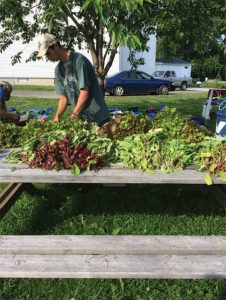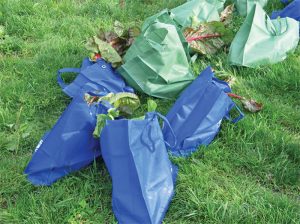Bulletin #4311, Planning and Managing a Community “Giving” Garden in Maine (Sections 18-20)
Planning to Start Your Deliveries
There are several key things to consider when you are planning to start your deliveries: 1) Find out who wants food; 2) Get donated bags from a local grocery; and 3) Set your food delivery day and deliver on that day so that the recipients will expect you. We have always worked on Tuesday evenings and Saturday late mornings. We devote Tuesday nights to food delivery. This helps the food recipient know when we are coming. Once we start harvesting, we use Saturdays to replant beds, weed, water, feed, and do basic plant management.
We deliver to approximately 40–50 people primarily in low-income senior housing located near the garden. When our town had a “town nurse,” we worked with her to identify other people in the community who could use the food. I have traditionally picked a rainy day to send my student workers to knock on doors and see if the respondent would like to receive food. We generally return two more times to the doors where no one responds.
We make two lists (one for each development), and add names of other people who live nearby and request food. Given the age group of people we deliver to, inevitably some people will be away visiting family, on vacation, or ill (in hospital, rehab unit, or at home). For the most part, we use reusable grocery bags to put the food in. We seek donations of these from our local food store. We start the year with about 200 reusable bags. Most grocery stores like to support civic projects like this. Every other year we request new bags. We ask food recipients to hang them on their door if they want food that week. If the bag is there, but they don’t answer, we leave the food by the door. If we miss count, or have planned food for someone who isn’t there, we give the bag away to volunteers or others we think could use the food.
Harvesting and Delivering

It’s exciting when it’s time to start harvesting! We use a picnic table as our staging area.
It is a very good idea to wash off the table surface first with a hose to remove any old food, bird feces, or other unwanted things. We place the reusable bags out, by housing development, based on the number of recipients in the units. Some married couples in the past have asked for two bags. In the past, I have determined on Saturday or Sunday what will be the likely food to be delivered that week. I then sit down and try to find or think up a great recipe to accompany the food. These tend to be simple, few-ingredient recipes that have been quite popular. We write them a short letter, provide the recipe, and put that in an envelope, which goes in the bag.
Table 2 shows the fruits of one of our production seasons. We tracked what we produced and gave away in a year (nearly 3,100 pounds of produce!). This could be helpful to see what we were able to harvest by when. I don’t have all the vegetables delivered in a given day in this table, but more this is to show you what vegetables are ready to harvest and when. The first column will reflect the new vegetable delivered by week.
| Date | Weight of bags | Some of the vegetables delivered by date* | |||
|---|---|---|---|---|---|
| 30-Jun | 1 | Lettuce | Swiss chard | Microgreens | |
| 7-Jul | 2 | Beet greens | Garlic Scapes | Swiss Chard | Lettuce |
| 14-Jul | 3.5 | Cabbage | Kale | Garlic Scapes | Lettuce |
| 21-Jul | 3.5 | Summer squashes | Cabbage | Broccoli | Swiss chard |
| 28-Jul | 4 | Cucumbers | Summer squashes | Cabbage | Kale |
| 4-Aug | 4 | Green beans | Garlic | Summer squashes | Cucumbers |
| 11-Aug | 4 | Potatoes | Green beans | Cucumbers | Summer squashes |
| 18-Aug | 4 | Onions | Potatoes | Green beans | Cucumbers |
| 25-Aug | 4 | Tomatoes | Garlic | Onion | Potatoes |
| 1-Sep | 6 | Rutabega | Beets | Onion | Potatoes |
| 8-Sep | 6 | Bell Peppers | Tomatoes | Green beans | Potatoes |
| 15-Sep | 6 | Sweet corn | Leeks | Potatoes | Tomatoes |
| 22-Sep | 8 | Winter squash | Potatoes | Leeks | Tomatoes |
* the first and second columns reflect the new vegetables maturing and ready for delivery
We load up the bags into a wagon for one group and a pickup truck for the other. The best part of the program is talking to the recipients. Sometimes they are perfectly well, take the food, chat a bit, and we move on. But other times they appreciate talking longer with someone, especially when something isn’t right. Friendships can blossom from this that can be quite amazing. For many years I delivered food to a lady in her 90s who lived alone, then had in-home care, and then finally passed away. We became great friends. Another lady used to wait for me in her outdoor swing on nice summer nights. We shared books and stories. I loved her pudgy dog, Buddy. I will remember that friendship forever.
How Long to Deliver
We have typically harvested vegetables and continued our deliveries until the third week of September. We typically hope to harvest and deliver almost everything that we have planted. This tends to influence repeat plantings. I would rather cover crop (explained below) with something cheap and easy like oats and peas, than cover crop with vegetables that don’t get harvested. Based on when you do your harvest and delivery, as September progresses, daylight shortens. We start our delivery at 4 p.m., and by the third week of September it’s getting dark by 7 p.m. We try to be done by 7 p.m. on harvest night anyway so that volunteers can get home and prepare a meal. So, if you wish to deliver later in the year, you might want to deliver on another day (perhaps Saturday afternoon). For our program, these dates and times have worked well. I have lots of other research harvesting duties in late September and October, so I needed to be done.
In complying with the letter and spirit of applicable laws and pursuing its own goals of diversity, the University of Maine System does not discriminate on the grounds of race, color, religion, sex, sexual orientation, transgender status, gender, gender identity or expression, ethnicity, national origin, citizenship status, familial status, ancestry, age, disability physical or mental, genetic information, or veterans or military status in employment, education, and all other programs and activities. The University provides reasonable accommodations to qualified individuals with disabilities upon request. The following person has been designated to handle inquiries regarding non-discrimination policies: Director of Equal Opportunity and Title IX Services, 5713 Chadbourne Hall, Room 412, University of Maine, Orono, ME 04469-5713, 207.581.1226, TTY 711 (Maine Relay System).


